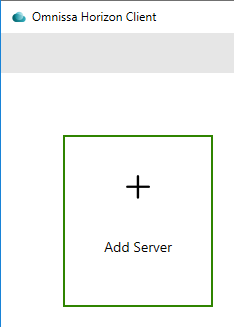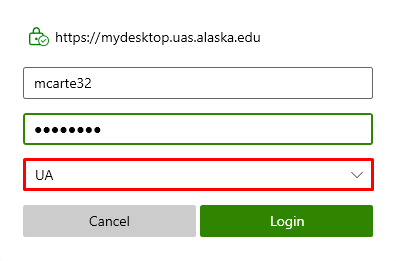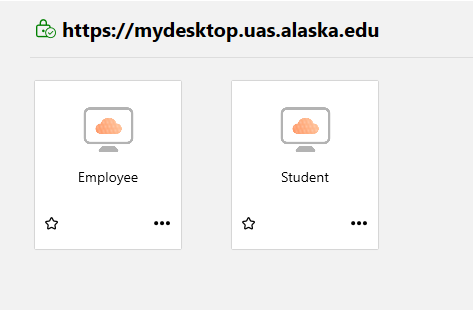Access your UAS Virtual Machine
Windows/Mac
That page explains more information about what a Virtual Computer, or Virtual Machine (VM), is, as well as how to request one. VMs can be accessed through the Omnissa Horizon Client which you need to install, or through an IT-configured Stratodesk computer.
Omnissa Horizon client
Please note: accessing the virtual infrastructure requires being on the UAS network, either through a campus connection or VPN. The Omnissa Horizon client is only available for Windows and Apple computers. Tablets and Chromebooks are unable to connect to virtual machines.
- Once the client has been installed (available through mydesktop.uas.alaska.edu), launch the program and add a New Server.

- Enter mydesktop.uas.alaska.edu and click Connect.

- Enter your UA Username & passphrase, set the Domain to UA, and click Login.

- Double-click the server to access it. From this point, it will be shown automatically.

Stratodesk
A Stratodesk computer issued by IT Services has Omnissa already installed and configured to connect to the mydesktop.uas.alaska.edu server. If not, add it as shown above.
- Launch the Omnissa Horizon Client.
- Double-click on mydesktop.uas.alaska.edu to access the server.
- Log in with your credentials.
- Double-click on Employees to access your VM.
FAQ
A virtual machine is a customizable computer designed to be accessed from a variety of locations. It works similarly to non-virtual computers but is located on UAS servers. Employees and students can access their virtual machines on any computer with a licensed Omnissa Horizon Client installation and an internet connection (campus or VPN).
Virtual machines and non-virtual machines differ in several ways:
- virtual machines are independent of hardware
- Omnissa can be accessed from any computer that follows our license agreements
- offer greater flexibility than physical machines
By shutting the VM down and changing its settings, ITS also can:
- add or reduce the server's memory
- add or remove a processor
- add a virtual disk
- increase an existing disk size
There is also a snapshot feature that lets you save the state of the server in case you need to restore it later on.
Virtual machines and Omnissa have many benefits:
- Virtual Machines are independent of user hardware. They are accessed through Omnissa, which can be installed on any computer that follows our license agreements (Windows or macOS).
- Consistent work environment across multiple devices on one profile.
- Omnissa is fully compatible with older machines that may independently have issues with newer software.
- ITS can rapidly deploy a common, supported desktop environment across the network.
- Updates can be managed centrally, ensuring that all virtual computers are consistently up to date.
- Central management of each standalone workstation across the entire virtual environment.
- Users connecting to a virtual desktop can have full access to all features of that VM without impacting the other virtual desktops or the host server.
Virtual machines are not for everyone. If your job requires you to travel or you are frequently away from a stable internet connection, virtual machines are not well suited for you.
- An internet connection is required. Loss of the internet results in disconnection from your virtual machine. This results in no loss of data.
- If your job requires you to travel or you are frequently away from a stable internet connection, virtual machines are not well suited for you.
- Audio output via HDMI is currently unavailable. This is primarily a concern for folks making frequent presentations or lectures.
- Hardware settings (like batteries) can't be changed from the virtual environment. This limits your external customization (but you still have control outside of the virtual space).
- Virtual machines do not recognize internal disk drives. You will need to use an external disk drive.
- External monitors may require additional configuration.
Stratodesk is an operating system, like Windows 10/11 or macOS. At UAS, this OS is set up to grant quick access to virtual machines using the Omnissa Horizon Client. Student computers on campus, as well as designated employee machines, run on Stratodesk.
Omnissa Horizon Client: This is a downloadable client used to access your virtual computer, available at mydesktop.uas.alaska.edu. It can be installed as an app on Windows and macOS.
Yes, we can create a virtual machine for you. It will be a standard Windows Virtual Machine; we do not currently have a macOS virtual environment. Any VM we create will be accessible from any university-purchased computer with Omnissa installed, Macs included.
Yes! Horizon client can be run from a wide variety of devices. UAS is licensed to access our virtual machines from any UAS-owned or leased Microsoft or Apple computer.
It is recommended to not only disconnect from the VM but also log out when you don't expect to be using it for an extended period.
- In Stratodesk, these options are located on the Omnissa bar on the Connection menu, where you can either Disconnect or Disconnect and Log off.
- In Omnissa Horizon Client for Windows, these options are available in the Omnissa bar at the top of the screen on the Options menu.
What's the difference?
- Disconnect: stop viewing your VM. It will remain running on the server. You can return to your VM, in the same state you left it.
- Disconnect and Log off: stop viewing your VM. All programs will close and you will be logged out. When you next access your VM, you'll start fresh.
If you encounter any issues while accessing your VM, call the UAS IT Helpdesk at 907-796-6400 for immediate assistance.
Employee Virtual Machines save your changes, unlike the student Virtual Builds. It is still recommended to save to a department fileshare when using documents you wish to share.